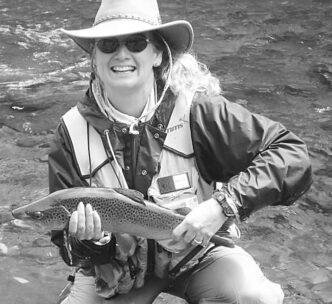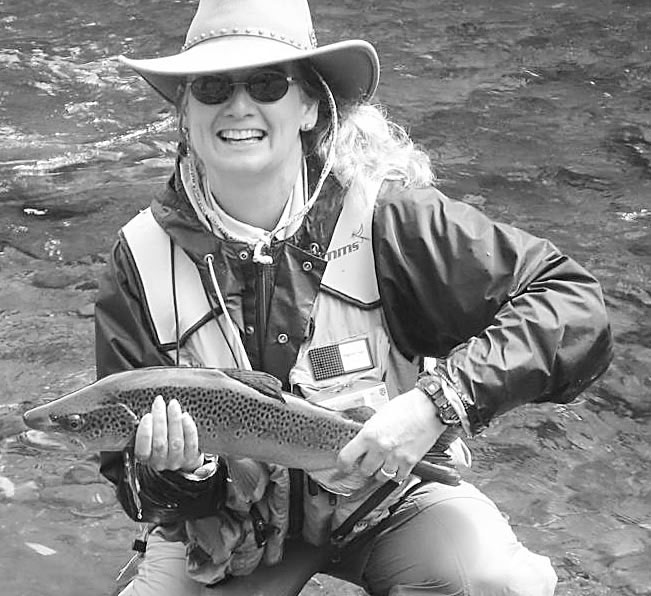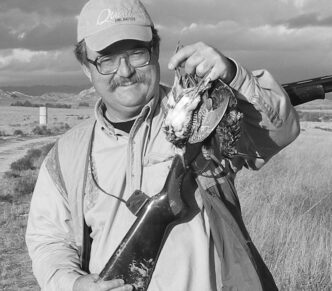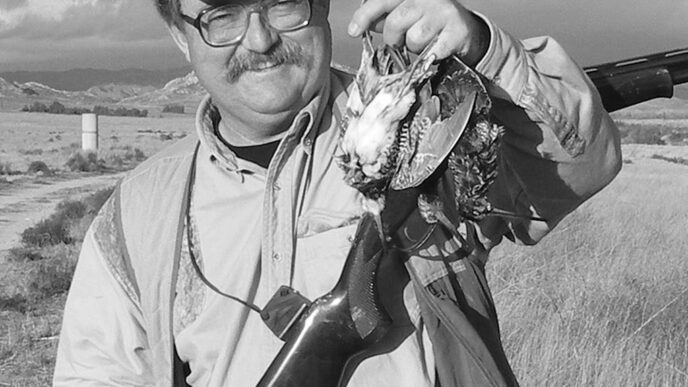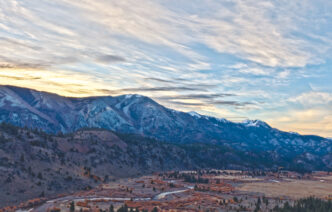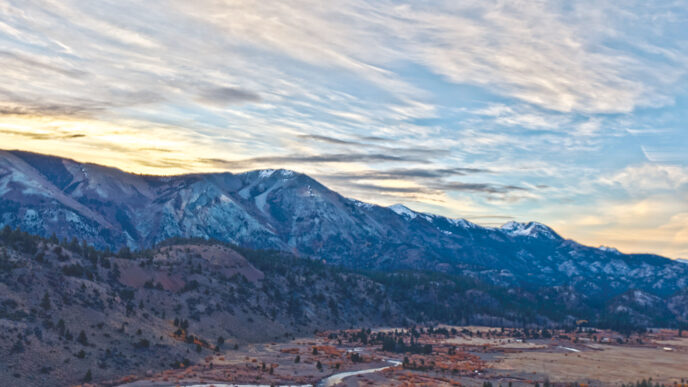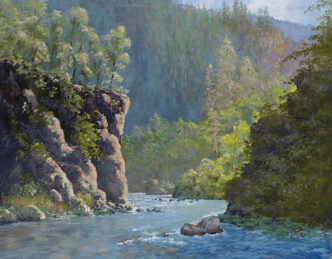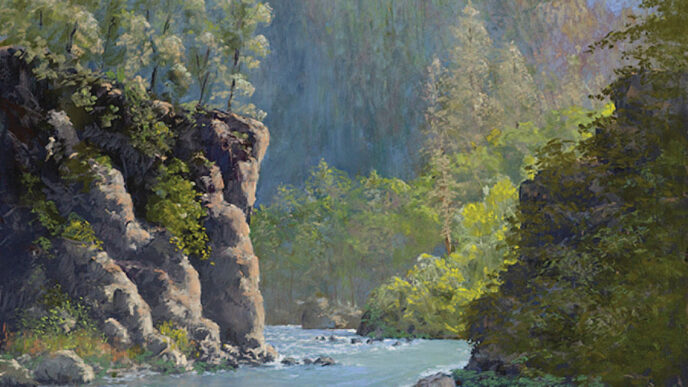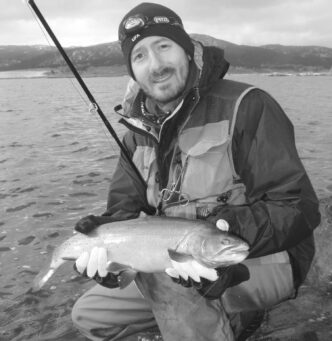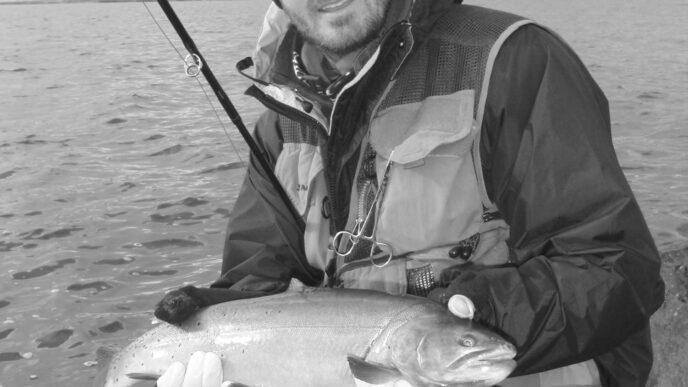There are fly fishers who are loners — the angling literature is full of people who, like Hemingway’s Nick in “Big Two-Hearted River,” are fishing to get away from it all. But a lot of fly fishers are joiners — people who, however much they value the solitude to be found in nature, also find comfort, support, instruction, and joy in the society of others. Of these joiners, however, only a few are leaders, because the commitments of time and energy and the frustrations of leadership are not something that everyone is willing to accept. Good leaders lead for good reasons, and one of those has been Anne-Marie Bakker, who has served as president of the Golden Gate Angling and Casting Club, the Golden West Women Flyfishers, and the Northern California Council of the Federation of Fly Fishers. We wanted to find out more about what brings people into such organizations and what it takes to keep them going. AnneMarie was clearly the person to ask.
Bud: When I interviewed Barbara Klutinis for the September/October 2010 “California Confluences” column, she noted that many women come to fly fishing somewhat late in their lives, with other matters absorbing their time and energies before that. It’s not necessarily a gendered thing, though — I followed the same trajectory. And she also noted that many women turn to the sport for the same reasons men do — a love of the outdoors and because their fathers or grandfathers fished. What brought you to fly fishing, when did you start, and who helped?
Anne-Marie: There isn’t a tradition of fishing in my family, but I grew up in the outdoors. No playing with dolls for me. I was lucky to grow up in a time when kids were allowed to wander. I spent my childhood in Maryland exploring the local woods and streams, catching frogs and turtles, and building tree forts. Vacations as a kid included camping and hiking, and as we got older, backpacking. We camped all over the East Coast, Canada, and ventured out as far as Colorado and Utah. One memorable trip was a three-week extravaganza out West to Colorado, Utah, and New Mexico, seeing Rocky Mountain National Park, Mesa Verde, Arches, and many other wonderful places.
While I was at Virginia Tech (studying biology, of course), my parents moved to California. When I graduated, I moved out West, too. I was looking to find friends like me who loved the outdoors. I was dating a guy who was just learning to fly fish, and he took me to the San Mateo International Sportsmen’s Exposition. I met all kinds of people who where enthusiastic about fly fishing, and I learned about all the wonderful places to go fishing and the camaraderie in the fly-fishing community. I was in the middle of completing my master’s degree in environmental management at the University of San Francisco, so I couldn’t jump right in then and there. I decided that once I completed my coursework — classes every Saturday for a year — I would treat myself to a five-day learn-to-flyfish course at Clearwater House. And I did! There I met a great friend, Mike Yee, who became my fly-fishing mentor. Living in the avenues of San Francisco, I joined the Golden Gate Angling and Casting Club and the Golden West Women Flyfishers. I was immersed in fly fishing, absorbing fly-fishing skills as fast as a I could. To this day, I still feel that there is so much to learn. It feeds my curiosity about the world we live in, how ecosystems work, and our role as stewards of the planet.
Bud: You ended up not just joining the Golden Gate Angling and Casting Club and the Golden West Women Flyfishers, but also the Northern California Council of the Federation of Fly Fishers and becoming a very active member in each. Solitude is one of the attractions of the sport, and even when we seek out others, many club members are content to enjoy the benefits of membership without much further exertion. What motivated you to join and work hard for these organizations? Why should others do so?
Anne-Marie: Solitude . . . really? I think this is a myth perpetrated by the literature. Well, when I’m actually on the river, there is solitude, but I have to tell you that most of my fly-fishing friends are pretty darn social, and fly fishing became my social network. Who else would appreciate a story about catching a 16-inch rainbow trout on the McCloud using a stonefly-dropper rig on the third riffle at the Conservancy? There are many venues where fly fishers meet: trade shows, fly-fishing expos, both those put on by FFF International and our own regional fly-fishing events, where we bring together the community to introduce new people to fly fishing, as well as to reconnect with old friends. I also think of the legendary Saturday night potlucks at Golden West outings, fishing Pyramid Lake, and informal fly-tying and wine-sipping with local flyfishing friends at the Glen Ellen Firehouse each month.
I certainly have taken off and fished on my own. I thoroughly enjoy the solitude. But this is the exception for me. I have to admit that my husband worries when I go off by myself, and this gives me pause.
Why participate in so many different organizations? Each organization has a unique character that I enjoy. When I started fly fishing, I lived four blocks from the Golden Gate Angling and Casting Club, so of course I joined. I remember stopping by the ponds after work to practice casting and hanging out with Armando Bernasconi and the gang on Saturdays. It is such a serene, peaceful place, even when the fog is coming in and the wind is swirling in the trees that surround the ponds. I met lots of wonderful people who taught me to cast and to tie flies, and I’ve got to meet some of the stars of the fly-fishing world who made the pilgrimage to the Angler’s Lodge. I love the history of the place and the opportunity to become friends with many of the great tyers, casters, and flyfishing innovators who came out of the Golden Gate club.
I joined the Golden West Women Flyfishers to go fishing. The GWWF always has a great variety of fishing trips throughout California. There is something about the camaraderie among women that creates a warm, inviting environment.
I joined the Northern California Council Federation of Fly Fishers because of its strong commitment to conservation. There seems to be such an endless number of threats that face our beloved fisheries. The opposition is often contentious, well-funded, and politically connected. Can we let them run roughshod over our precious world in the name of profit?
I’m active in all these organizations because I believe strongly in what they are doing. Active participation creates a stronger bond to the organization. I have the opportunity in a small way to strengthen the organization. It’s essential for members to participate. Many organizations are struggling to recruit people to volunteer. If there is no help, then organizations have to pare back on what they can accomplish, reduce what they are able to offer their membership, and ultimately this is detrimental to the organization. I’ve heard that 20 percent of the members of such groups actively participate in their organization. Think about the clubs you belong to. What if everyone participated, even in a small way? The number of things that could be accomplished would be incredible!
Bud: Heading up an organization, or even just participating in its “leadership cadre,” as we Mickey Maoists called them in the 1960s, can be an exercise in herding cats. Your professional life in the field of environmental health and safety sounds like it may have prepared you for this aspect of leadership. Did it?
Anne-Marie: No kidding — it is herding cats, and it seems to me that fly fishers (including me) are an independent lot. Being in environmental health and safety was great preparation. EH&S is a support function in a company. The consequences of noncompliance can be serious for the organization, and yet you have no direct supervision over the workforce. It’s taught me to be very organized, go the extra mile to get things done, be able to present your plan in a clear, concise manner, and to be prepared for pushback and to answer lots of questions and to find compromise without compromising what’s essential.
The same thing happens when you are running a volunteer organization, but there are different motivations. I don’t have regulations in my tool box that provide incentive to do what is needed. Members have volunteered to participate in your club, and you have to motivate your members to buy into what the organization is about and the goals that we are trying to achieve. If members are not on the same page, it can affect what can be accomplished.
I’ve never felt that it’s been a disadvantage to be a woman, though. I grew up in a family that encouraged me to be independent and to stand up for myself. I was lucky to grow up in a generation that changed the roles and expectations for women, and it has been a great benefit for me. I won’t put up with being treated unfairly.
Bud: Is there any difference between leading an organization such as the NCCFFF and an organization such as the Golden West Women Flyfishers? If so, what, and how did you deal with it? If not, why do you think that is?
Anne-Marie: I think there isn’t much difference in leading both organizations other than the size and the scope of the organization. Running the GWWF was more informal, collegial. Leading the NCCFFF was a part-time job. For work, I decided to do go into EH&S consulting so I could have a more flexible work schedule. In the NCCFFF, you work with a large board and you are representing 32 clubs in Northern California and Northern Nevada. There are lots people with differing opinions and more discussions, and consensus building is needed before a decision can be made.
Bud: What do you view as your principal accomplishments? What were your principal frustrations, and how did you deal with them?
Anne-Marie: I think my biggest accomplishment is being a facilitator. I’m willing to jump in and do what’s needed to move a project forward, whether it’s
leading an organization, chairing fundraisers, spending a week working with the Department of Fish and Game in the Golden Trout Wilderness, or attending a DFG commission meeting. I’ve done just about any task you can imagine. For me, it’s hard to list specific accomplishments. None of what I’ve accomplished is done in a vacuum. Most what has been accomplished by the organizations I’ve belonged to has been done by many people, and I don’t want to take credit.
In leading a variety of organizations, I’ve learned that you can’t please everyone. You must respect other people’s views, but at some point, you may have agree to disagree and move on. Continued bickering within a group can really damage the collegial atmosphere. You must compromise. It’s never just black or white; it’s a gray world. I see this in every conservation issue that we’ve worked on. We cannot get everything we want. We must look at the big picture. We will not win with an all-or-nothing approach.
Bud: When I was preparing for this interview, one of the things that struck me was the way in which traces of your work turned up in issue after issue — too many to recap here. Fighting the good fight looks an endless sequence of battles. Some management gurus suggest making a prioritized list, dealing only with the top three, and then moving issues up as those get resolved. How do you handle the process?
Anne-Marie: In my work life, definitely, you prioritize, and the parameters for setting the priorities are straightforward. In volunteer organizations, there are many other factors. You need someone to champion the conservation issue or take on the task of organizing a fundraiser. You need support from the membership, the board, and the volunteers necessary to complete the project.
What is the organization good at? Is the project too big or not in our area of expertise? Do we have the necessary funds? At the NCC, we have a strong conservation committee because we have very dedicated board members who give many hours of their time. I can’t say enough about the hard work that Mark Rockwell has put in on negotiations for removing hydroelectric dams on the Klamath River, FERC relicensing on the McCloud, and now the Delta issues. Cindy Charles has been working tirelessly on the Alameda Creek restoration and is beginning to work on FERC relicensing of the dams on the Merced and Tuolumne Rivers. Then there’s Doug Lovell and Striperfest working on striper and Delta issues, Dougald Scott and the Steelhead Committee working on Central Coast stream issues and participating in the Salmonid Restoration Conference. I’d like to say that we have a procedure to prioritize, evaluate, and decide the projects we take on. But I have to say it’s somewhat hit or miss.
Bud: The Federation of Fly Fishers is something of an umbrella organization, relating to or coordinating efforts by a number of other groups. Its mission statement declares that the FFF is “dedicated to the betterment of the sport of fly fishing through Conservation, Restoration and Education. The Federation of Fly Fishers and its Councils are the only organized advocate for fly fishers on an national and regional level.” But as the saying goes, all politics is local. What are the problems and possibilities of relating the concerns of individuals and smaller groups to the larger issues that affect anglers on a regional, statewide, and national scale?
Anne-Marie: The beauty of the Federation of Fly Fishers is the independence of the regional councils. We focus on regional and local issues and deal with them at the council level. Each council has its own set of priorities. For us at the Northern California Council, it’s conservation. There is a tremendous amount of stuff going on in this arena, from FERC relicensing on most of the major rivers in California for the past 15 years to the latest proposals to restore the Delta ecosystem. So this has to be our focus.
That’s not to say that we neglect other tenets of the FFF. We have tremendous Trout in the Classroom and Veterans First fly-fishing programs. We also have an annual Fly Fishing Expo to promote fly fishing, teach fly tying and casting, and provide seminars on fishing destinations. The national organization provides support for our efforts. They provide resources and training material for teaching casting, tying, and general fly-fishing skills. They developed and manage the casting certification program. The national organization has also developed conservation policies promoting catch-and-release angling, preserving native species, and controlling invasive species such as the New Zealand mud snail. I would like to see the FFF add a conservation position at the national office, though. We need to be getting involved with nationwide threats to our environment, such as global warming and the efforts to dismantle the Endangered Species Act.
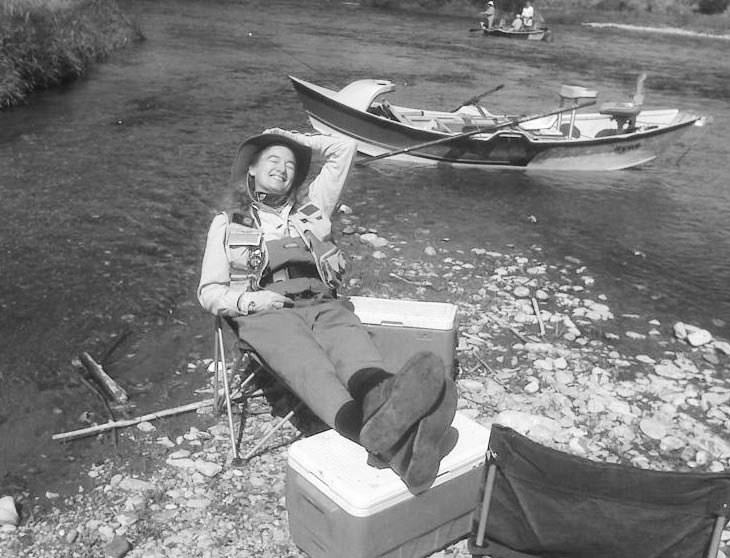
Bud: Looking ahead to a world in which climate change may transform the environment and national political tides promise to run strong, what do you see as the imperatives for protecting the future of the sport, the natural environment that supports it, and the articulation of the link between the two?
Anne-Marie: The first thing that needs to be done is to stop this nonsensical argument that climate change is not real. The data are there. Please don’t get me started on the lack of science education in the United States. Would we continue to argue about the validity of the data if average Americans had a basic understanding of how the scientific method works? We cannot move forward if people are not on the same page, moving to a common goal. I’ve just attended a conference on sustainable laboratories. There a several programs, including government initiatives, that provide incentives for business to build green sustainable labs. For many companies and the government, climate change is real, and they are investing in new technologies and new building designs to reduce energy consumption and to recycle building materials. We all must become conscious of our impacts on the Earth, then make changes. We cannot go on as we have, and the longer we wait to make the needed changes, the more painful it will be to our quality of life. I believe that the longer we wait, the more impact that will have on the environment. Many species are at historically low numbers. This reduces the resilience for a species to adjust to climate change. Further reduction of suitable habitat will compound the current situation.
We must learn how to share our resources for the most benefit to all, including preserving habitat and the animals that need it to survive.
Bud: We haven’t actually talked much about fishing — just the things that take you away from it. Do you actually get to fish? Where? When? How?
Anne-Marie: I fish quite a bit, mostly for trout and steelhead, although I’ve been branching out to saltwater fishing the last couple of years. It’s a perk of working as an independent consultant. California has some of the best fishing waters. My favorites are the Pit and McCloud. I love them because they are a little harder to get to. The extra effort is rewarded with beautiful scenery and great fishing.
The best way to enjoy these rivers is to camp and hike. There is nothing like waking up in the morning and seeing the sunlight on the meadow at Ah-Di-Nah Campground on the McCloud. Who needs a four-star hotel! Lately, I’ve fallen in love with the eastern Sierra. My favorite there is the Owens River. It’s got great dry-fly fishing with stunning views of the Sierra to the west and the White Mountains to the east. The Southwest Council is planning the first-ever Fly-Fishing Faire in Mammoth Lakes in September. I can’t wait to go! There are so many other great places: the Yuba, Sacramento, Fall, and Trinity Rivers, Hot, Hat, and Burney Creeks, any high-country stream that holds golden trout, and the Delta for stripers. I’ve just started surf fishing seriously. I’m part of a fishing survey coordinated through the Bodega Bay Marine Lab. Talk about a whole new ballgame. I love the challenge.
I’ve also fished in Oregon, Nevada, Idaho, Montana, Wyoming, Colorado, New Mexico, Texas, Maryland, Florida, Massachusetts, and even Tennessee. I’ve gotten into the habit of taking my fly rod with me on business trips and searching out local fishing opportunities. It’s been great fun to explore new areas.
I’ve done a little fishing internationally — British Columbia, New Zealand, Belize, and France. All have been great adventures, New Zealand being my favorite because there is so much to do along with the fishing. Fishing in far-flung places is great fun, but I find that I don’t have the same attachment to these places as I do for the local waters.
Bud: And now we come to the moment of truth: the Silly Tree Question. If you were a tree, what kind of a tree would you be?
Anne-Marie: I think I would be a cottonwood. Here in the West, you see a cottonwood tree across a meadow, and you can find a stream. The cottonwood provides shade to keep the water cool and protects the stream bank from eroding. The roots provide cover and habitat for the aquatic animals. The cottonwood is a sentry that watches over and protects the stream. OK, it’s a little corny, but we definitely need more human cottonwood trees out there!



